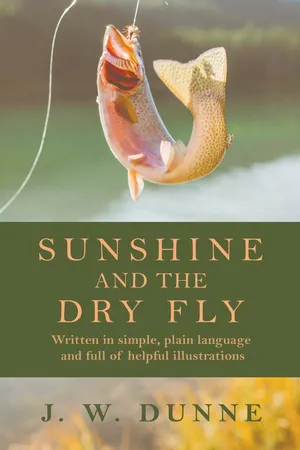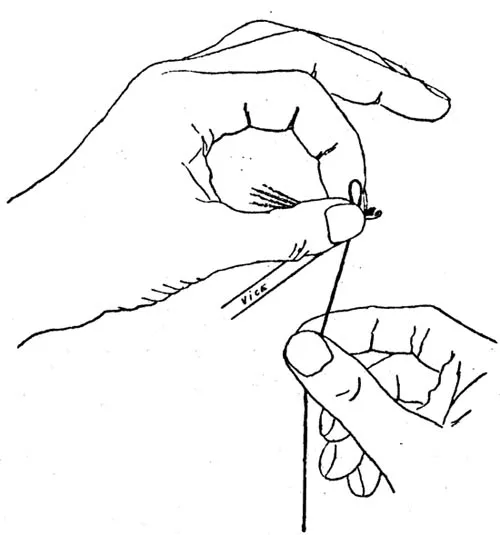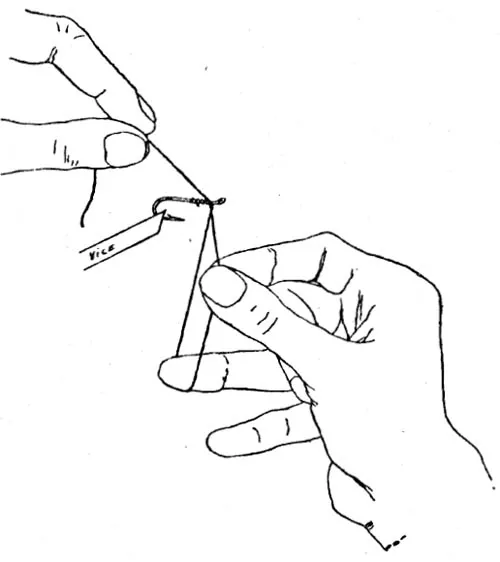
- 142 pages
- English
- ePUB (mobile friendly)
- Available on iOS & Android
eBook - ePub
Sunshine and the Dry Fly
About this book
"Sunshine and the Dry Fly" is a classic guide to fly-fishing, with a special focus on fishing for trout. Written in simple, plain language and full of helpful illustrations, this volume represents a timeless handbook for the fly fisherman, and it would make for a fine addition to collections of related literature. Contents include: "Troubles of a Beginner", "Against the Light", "The Blue-Winged Olive", "The Sherry Spinner", "The Sense of Colour", "Pale-Wateries", "Pale-Wateries (continued)", "Olive, Iron-Blues, Brown Ants, and Black Gnats", "Mostly About May-Flies", "The Trout and the Fly – A Psychological Speculation", "Cavear Juvenis", etc. Many vintage books such as this are increasingly scarce and expensive. It is with this in mind that we are republishing this volume now in an affordable, modern, high-quality edition complete with a specially-commissioned new introduction on the history of fishing.
Frequently asked questions
Yes, you can cancel anytime from the Subscription tab in your account settings on the Perlego website. Your subscription will stay active until the end of your current billing period. Learn how to cancel your subscription.
At the moment all of our mobile-responsive ePub books are available to download via the app. Most of our PDFs are also available to download and we're working on making the final remaining ones downloadable now. Learn more here.
Perlego offers two plans: Essential and Complete
- Essential is ideal for learners and professionals who enjoy exploring a wide range of subjects. Access the Essential Library with 800,000+ trusted titles and best-sellers across business, personal growth, and the humanities. Includes unlimited reading time and Standard Read Aloud voice.
- Complete: Perfect for advanced learners and researchers needing full, unrestricted access. Unlock 1.4M+ books across hundreds of subjects, including academic and specialized titles. The Complete Plan also includes advanced features like Premium Read Aloud and Research Assistant.
We are an online textbook subscription service, where you can get access to an entire online library for less than the price of a single book per month. With over 1 million books across 1000+ topics, we’ve got you covered! Learn more here.
Look out for the read-aloud symbol on your next book to see if you can listen to it. The read-aloud tool reads text aloud for you, highlighting the text as it is being read. You can pause it, speed it up and slow it down. Learn more here.
Yes! You can use the Perlego app on both iOS or Android devices to read anytime, anywhere — even offline. Perfect for commutes or when you’re on the go.
Please note we cannot support devices running on iOS 13 and Android 7 or earlier. Learn more about using the app.
Please note we cannot support devices running on iOS 13 and Android 7 or earlier. Learn more about using the app.
Yes, you can access Sunshine and the Dry Fly by J. W. Dunne in PDF and/or ePUB format. We have over one million books available in our catalogue for you to explore.
Information
eBook ISBN
9781447492986Subtopic
ZoologyAPPENDIX I
DIRECTIONS FOR TYING THE NEW FLIES
ELEMENTARY CONSIDERATIONS
FOR readers who have not previously attempted to tie flies, the principles underlying the general procedure must be briefly explained.
It is always assumed that the hook is fixed in the vice with the eye pointing to the right. Unless directions are given to the contrary it is also assumed that all winding on to the shank is effected “right-handed,” which means that the material goes away from you as it passes over the shank, and comes towards you underneath.
A piece of fine silk, called the “tying” silk, is laid on the shank at the “neck” (i.e., just behind the eye), and is fastened in place by winding it towards the bend over its own end. All other materials are tied in by the simple process of laying them on the shank and winding this piece of tying silk once or twice tightly round both. It sounds simple; and it would be simple, but for one thing. The tightening of the turn of tying silk is apt to pull the other material round the shank. Any bunch of fibres treated thus is consequently split up. Hence the process must be effected as follows:
The material is laid in position on the shank, and both are pinched firmly between the left finger and thumb, which are held so as to form as wide a circle as possible. The tying silk is then brought up on the near side of the shank, and pulled backwards (i.e., towards the bend) so that it works in between thumb and shank, the thumb being rocked slightly back on its ball to allow of this. The silk is then taken over the top of the shank, not closely, but so that it stands up in a half-hoop, and is similarly worked in between the forefinger and shank on the far side: the position at this moment being as shown in Fig. 4.

FIG. 4.
Everything is then pinched firmly again between finger and thumb while the tying silk is drawn tight. The process is repeated as many times as may be needed. It is not necessary at all when you are merely tying in the end of some material which has already been wound on the hook, and so can be drawn taut with the other hand while the silk is carried over it.
Hackle-pliers are pliers which are closed, instead of opened, by their springs. When the tying silk is not in actual use, it is left hanging with a pair of these pliers attached to its end to keep it taut.
Hackles are usually tied in by the thick ends of their stems, from which ends all the lower, fluffy, downy fibres have been removed. No pinching with finger and thumb is needed here. A pair of hackle-pliers is then attached to the hackle point, and the feather is pulled out at right angles to the shank, with its glossy surface facing towards the hook eye. It is then wound round the shank, being kept carefully on edge meanwhile. The pliers are constructed with a ring in which the forefinger may be placed, and if held thus, by the forefinger alone, no twist is imparted to the stem of the hackle during the winding. The pliers are not removed till the hackle point has been firmly tied down by the tying silk.

FIG. 5.
The tying of the fly generally ends at the neck, where the tying silk has to be finally fastened off. This is effected by means of a “whip finish.”
Keep the silk drawn tight with the forefinger and thumb of the right hand; lay the third finger of the same hand across the silk at the far side. Reach round the back of the vice with the left hand; grip the hanging end of the silk and bring it up, round the right third finger, in front of the eye of the hook, and, finally, into the angle between the taut thread and the neck. The position will then be as in Fig. 5.
Keeping the loop taut with the right third finger, make a turn with the right forefinger and thumb over the top of the neck, binding down the end held in the left hand, which end should be drawn towards you as you go over. The left forefinger and thumb then release their hold and, encircling the hook, grip the silk on the far side just above the right-hand hold. The right hand then lets all go, and takes the new grip necessary to carry the silk over a second time. I generally make four turns thus. Finally, slip the dubbing needle into the loop to keep this taut, and pull slowly on the free end of the silk with the left hand, drawing towards the bend. Slip out the dubbing needle at the last moment, give a final pull, and cut off the waste end.
TOOLS, MATERIALS, ETC.
1. A long, flexible dubbing needle with a thin handle. The point of this needle must be rounded off smoothly on a stone, otherwise it will break the material. To be kept clean.
2. A fine needle for cleaning the eye of the fly, and to be kept for that purpose only. Do not use the dubbing needle for this.
3. A pair of fine-pointed tweezers.
4. Two hackle-pliers.
5. Fly-vice.
6. A set of reels of “cellulite” (procurable wholesale from Wardle and Davenport, Leek, Staffordshire, or retail from Messeena and Co., 94, Upper Clapton Road, London, E. 5).
7. A set of reels of the specially selected tying silks, used also for ribbing silks (procurable from Messeena and Co.).
8. A set of reels of the thicker sewing-machine silks used in some of the patterns. (Also procurable from Messeena and Co.)
9. Fine gold wire, and fine silver wire (used in some of the May-flies only).
10. Packets of the specially selected hackles. (Procurable from Messeena and Co.)
There is nothing special about the long-fibred hackles used for making whisks.
11. Methylated spirit for cleaning finger tips.
12. Fly-scissors.
13. Bottle of celluloid varnish (thin). No other varnish must be used. May be made by dissolving a few pieces cut from old and well-cleaned camera film in equal parts of acetone and amyl acetate.
14. A bundle of sheets of strong, stiff, shiny notepaper.
15. Bottle of the thickish, colourless paraffin sold by chemists for medicinal purposes.
PAINTING THE HOOKS
The hooks must be cleaned in a strong solution of washing soda and hot water. They should not have been bronzed in the first place, but if this has been done, they should be boiled for two hours in a saturated solution of the soda, which will remove the bronze, and bring them into fine condition for receiving the paint.
Keep a ...
Table of contents
- Cover
- Title
- Contents
- I. Troubles of a Beginner
- II. Against the Light
- III. The Blue-Winged Olive
- IV. The Sherry Spinner
- V. The Sense of Colour
- VI. Pale-Wateries
- VII. Pale-Wateries (continued)
- VIII. Olives, Iron-Blues, Brown Ants, and Black Gnats
- IX. Mostly about May-Flies
- X. The Window in the Water
- XI. The Trout and the Fly—A Psychological Speculation
- XII. Caveat Juvenis
- Appendix I.
- Appendix II.